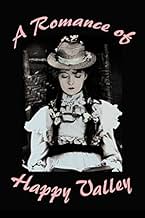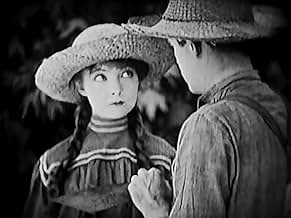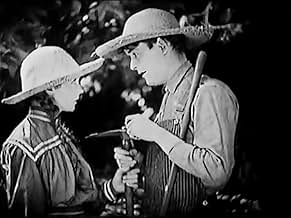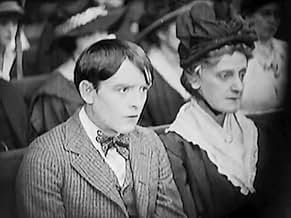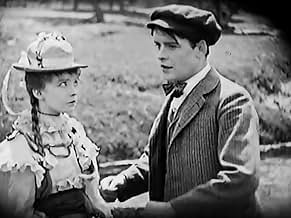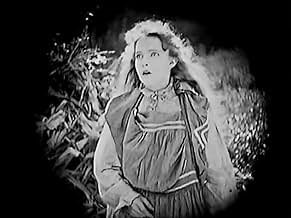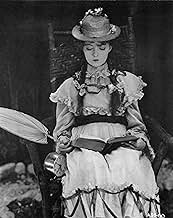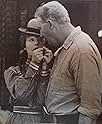अपनी भाषा में प्लॉट जोड़ेंJohn Logan leaves his parents and sweetheart in bucolic Happy Valley to make his fortune in the city. Those he left behind become miserable and beleaguered in his absence, but after several ... सभी पढ़ेंJohn Logan leaves his parents and sweetheart in bucolic Happy Valley to make his fortune in the city. Those he left behind become miserable and beleaguered in his absence, but after several years he returns, a wealthy man.John Logan leaves his parents and sweetheart in bucolic Happy Valley to make his fortune in the city. Those he left behind become miserable and beleaguered in his absence, but after several years he returns, a wealthy man.
Carol Dempster
- Girl John Logan meets in New York
- (बिना क्रेडिट के)
फ़ीचर्ड समीक्षाएं
Lillian Gish getting lovey dovey in her cute hats is the highlight in this creaky old film, but it's interesting that her budding romance is set within the context of country vs. City, a dynamic that's carried forward to the present day. Here New York is referred to as "Sodom and Gomorrah" by a preacher when the young man she has an eye on has aspirations of moving there. He's played by Robert Harron who's got good screen presence as well, but unfortunately this story fizzles because it veers away from being a romance for too long.
In the city there is no great temptation that he faces, just an innocent request to go out "stepping" (dancing), which he declines, so that he and the film can instead spend time rather anemically on him trying to get a toy mechanical frog working, which was a bit like watching paint dry. When he eventually does return home, a crime drama is cooked up with a stranger, which is compounded by a near fatal case of mistaken identity. I don't know if the film was aware of the irony of the crime and violence occurring in the town instead of the den of iniquity of the city, but regardless, it was completely uninteresting, and I longed for Gish to return to the screen.
In the city there is no great temptation that he faces, just an innocent request to go out "stepping" (dancing), which he declines, so that he and the film can instead spend time rather anemically on him trying to get a toy mechanical frog working, which was a bit like watching paint dry. When he eventually does return home, a crime drama is cooked up with a stranger, which is compounded by a near fatal case of mistaken identity. I don't know if the film was aware of the irony of the crime and violence occurring in the town instead of the den of iniquity of the city, but regardless, it was completely uninteresting, and I longed for Gish to return to the screen.
Some modern viewers understandably have a hard time sitting with silent films, and among other reasons, some instances especially epitomize the notion of "simpler entertainment for a simpler time." Intertitles may directly address the audience, or speak very exactly to what is happening in or represented by a scene, at the same time that the storytelling in some cases is as lighthearted as drama can be without being labeled as "comedy." Plot or character development may be very direct and uncomplicated. That's to say nothing of depiction of old-fashioned or downright antiquated values, and of culture and lifestyles far removed from our own. I think it's safe to say that all these facets are present in 'A romance of Happy Valley' in varying proportions, right down to the core of the narrative; I love the silent era, and still there are parts of this that I watch while barely suppressing derisive laughter of disbelief. Much as fantasy or science fiction may take us to an entirely different world, old titles like this might require the most robust suspension of disbelief to engage with.
Some silent movies are among the very best movies that have ever been made; others are well done and entertaining, but decidedly quaint. Given all the elements I've described, this feature is among the latter - but even at that, more than not it's a pleasure to watch, and all the more so for devotees of early cinema who recognize how such early pictures were made. The sets, costume design, and hair and makeup work are terrific, certainly helping to ease viewers into the experience. Films in the 1910s and 20s weren't necessarily known for particular nuance in the acting, but I think everyone here rather successfully imbues welcome heart and personality into their roles, letting the tableau feel meaningfully real even as other aspects might threaten our suspension of disbelief. To that point, too, while filmmaker D. W. Griffith has an asterisk or two on his legacy, there's no disputing that he was a leading icon of the industry in its earliest days, and he again proves why here with excellent, mindful direction orchestrating every shot and scene. Moreover, between Griffith's direction and the screenplay he penned with Mary Castelman, there some nicely subtle, clever inclusions that in and of themselves add much to the feature.
Mind you, for whatever value this can claim, and neverminding its idiosyncrasies, there are specific faults I would cite that weigh against it. The emphatic religious language seems very heavy-handed even for the narrative the feature has to impart. One would be remiss not to note the tawdry, tiresome use of blackface (to which Griffith was no stranger). More substantively: Among other subjective faults I would not count the tonal shift between the approximate first and second halves; on the other hand, all those factors I initially described above don't entirely hold true as the tone shifts, and that includes how intertitles are used. There comes a point when the storytelling becomes a tad muddled, and the production struggles to elucidate the precise course of events or who characters are. That goes for too much of the second half, which has fewer intertitles, choppier sequencing, and examples of emphatically weak lighting. None of this is helped by having two actors who look alike being dressed up in ways that make them even more indistinguishable from each other. While the broad story beats are clear enough, I don't believe the movie is entirely effective in communicating the movement from A to B to C, and the result feels like Movie Magic - or worse, perhaps the undeveloped storytelling of a young child ("This happened. And then this happened. The end."). If the writing of the backend were tightened, providing a more lucid narrative, the whole would have been drastically improved.
Considered overall I believe 'A romance of Happy Valley' is roughly on par with the bulk of its contemporaries - not super remarkable, but suitably well done despite glaring issues (the blackface), ham-handedness and outmoded norms, and other matters. The uneven dispensation of its storytelling is where I have the biggest problem, but then, maybe I'm being too cynical. In any event, the fact remains that when all is said and done this is surely a piece mostly likely to appeal only to those who are already enamored with the silent era, and other audience members can probably just move on. Even then there are many other titles that indisputably earn a higher priority, but if you happen to come across this one and are willing and able to parse with distinct imperfections, then it's not a bad way to spend 76 minutes.
Some silent movies are among the very best movies that have ever been made; others are well done and entertaining, but decidedly quaint. Given all the elements I've described, this feature is among the latter - but even at that, more than not it's a pleasure to watch, and all the more so for devotees of early cinema who recognize how such early pictures were made. The sets, costume design, and hair and makeup work are terrific, certainly helping to ease viewers into the experience. Films in the 1910s and 20s weren't necessarily known for particular nuance in the acting, but I think everyone here rather successfully imbues welcome heart and personality into their roles, letting the tableau feel meaningfully real even as other aspects might threaten our suspension of disbelief. To that point, too, while filmmaker D. W. Griffith has an asterisk or two on his legacy, there's no disputing that he was a leading icon of the industry in its earliest days, and he again proves why here with excellent, mindful direction orchestrating every shot and scene. Moreover, between Griffith's direction and the screenplay he penned with Mary Castelman, there some nicely subtle, clever inclusions that in and of themselves add much to the feature.
Mind you, for whatever value this can claim, and neverminding its idiosyncrasies, there are specific faults I would cite that weigh against it. The emphatic religious language seems very heavy-handed even for the narrative the feature has to impart. One would be remiss not to note the tawdry, tiresome use of blackface (to which Griffith was no stranger). More substantively: Among other subjective faults I would not count the tonal shift between the approximate first and second halves; on the other hand, all those factors I initially described above don't entirely hold true as the tone shifts, and that includes how intertitles are used. There comes a point when the storytelling becomes a tad muddled, and the production struggles to elucidate the precise course of events or who characters are. That goes for too much of the second half, which has fewer intertitles, choppier sequencing, and examples of emphatically weak lighting. None of this is helped by having two actors who look alike being dressed up in ways that make them even more indistinguishable from each other. While the broad story beats are clear enough, I don't believe the movie is entirely effective in communicating the movement from A to B to C, and the result feels like Movie Magic - or worse, perhaps the undeveloped storytelling of a young child ("This happened. And then this happened. The end."). If the writing of the backend were tightened, providing a more lucid narrative, the whole would have been drastically improved.
Considered overall I believe 'A romance of Happy Valley' is roughly on par with the bulk of its contemporaries - not super remarkable, but suitably well done despite glaring issues (the blackface), ham-handedness and outmoded norms, and other matters. The uneven dispensation of its storytelling is where I have the biggest problem, but then, maybe I'm being too cynical. In any event, the fact remains that when all is said and done this is surely a piece mostly likely to appeal only to those who are already enamored with the silent era, and other audience members can probably just move on. Even then there are many other titles that indisputably earn a higher priority, but if you happen to come across this one and are willing and able to parse with distinct imperfections, then it's not a bad way to spend 76 minutes.
"A Romance of Happy Valley" is a good smaller production from D.W. Griffith. It's very similar to and somewhat lesser than his later film also of the same year, "True Heart Susie". Both pictures star Lillian Gish and Robert Harron as lovers estranged for considerable length and are coming-of-age melodramas set in America's rural South. I'm not positive, but the same sets may have been used in both films; regardless, the locations are similar looking.
As in the later film, Gish plays a naïve, long-suffering country girl who awaits Harron's return from making good in the city. The narrative here isn't as well developed as that for "True Heart Susie" and, perhaps, one can view "A Romance of Happy Valley" as a bit of a trial run for the later film. The frog toy invention Harron makes good with seems as though it must be a joke I'm not getting. And, the contrived ending reused from Griffith's short film "The Son's Return" (1909) and the Judas character were unnecessary and irrelevant to the main story. A more abrupt reunion finale without the cheap surprise gimmicks would have been preferred.
Nevertheless, I like the film for its nice photography and good scene dissection between the picturesque countryside and closer views of the characters. The beauty of Bitzer's cinematography isn't as evident in the somewhat worn out print for this film as it is in the recent Film Preservation Associates restoration of "True Heart Susie" and in some of Griffith's other more prominent releases, but since "A Romance of Happy Valley" was considered lost until a print was discovered in a Soviet archive in 1971, we should, I suppose, consider ourselves fortunate. Additionally, arguably the best part of this picture, as was often the case in her films, is Lillian Gish's performance. She really makes her character appear featherbrained in this one, with her nervous skipping and wide-eyed look. The scene where she jerks her head right and left causing her hat to flip sides each time with her while she argues her need for more fashionable clothes to her father was especially amusing. And, her scenes with Harron's coat on a scarecrow rack, as a substitute for her estranged lover, are pitiful and poignant. (EDIT: It's interesting how similar this scene is to the one in "The Artist" (2011); I wonder if that's intentionally so.)
As in the later film, Gish plays a naïve, long-suffering country girl who awaits Harron's return from making good in the city. The narrative here isn't as well developed as that for "True Heart Susie" and, perhaps, one can view "A Romance of Happy Valley" as a bit of a trial run for the later film. The frog toy invention Harron makes good with seems as though it must be a joke I'm not getting. And, the contrived ending reused from Griffith's short film "The Son's Return" (1909) and the Judas character were unnecessary and irrelevant to the main story. A more abrupt reunion finale without the cheap surprise gimmicks would have been preferred.
Nevertheless, I like the film for its nice photography and good scene dissection between the picturesque countryside and closer views of the characters. The beauty of Bitzer's cinematography isn't as evident in the somewhat worn out print for this film as it is in the recent Film Preservation Associates restoration of "True Heart Susie" and in some of Griffith's other more prominent releases, but since "A Romance of Happy Valley" was considered lost until a print was discovered in a Soviet archive in 1971, we should, I suppose, consider ourselves fortunate. Additionally, arguably the best part of this picture, as was often the case in her films, is Lillian Gish's performance. She really makes her character appear featherbrained in this one, with her nervous skipping and wide-eyed look. The scene where she jerks her head right and left causing her hat to flip sides each time with her while she argues her need for more fashionable clothes to her father was especially amusing. And, her scenes with Harron's coat on a scarecrow rack, as a substitute for her estranged lover, are pitiful and poignant. (EDIT: It's interesting how similar this scene is to the one in "The Artist" (2011); I wonder if that's intentionally so.)
Watching silent films has been of great fascination for quite some time now and there are some truly fine ones, some revolutionary technically or in terms of subject. Not all are great and a few controversial, but there are many great or iconic ones. Among the best of them is the best of DW Griffith, and the more that has been seen of Griffith's work (short and feature films) the more interesting he has come to me. We also have Griffith regular Lillian Gish, among the greatest silent film actresses, in the lead role.
'A Romance of Happy Valley' is not one of Griffith's best, it is not quite 'Intolerance', 'True Heart Susie', 'Orphans of the Storm', 'Way Down East' and 'Broken Blossoms' level, all very good to brilliant. Much prefer it though over 'Birth of a Nation', appreciate its importance but the second half spoilt it significantly for me, and especially 'Abraham Lincoln' (with him being one of not many silent film directors to clearly not transition well into sound). 'A Romance of Happy Valley' is somewhere in the middle as far as his work goes and is a very good representation of Gish.
There is actually not a huge amount wrong with 'A Romance of Happy Valley' in my view. The story is very slight, making for some ploddy moments in the less eventful stretches, and quite old-fashioned.
Do agree too that the ending came over as far-fetched and quite weird even, actually found it rather out of place and shoehorned in and it is a rare case of me saying that an abrupt and pat ending (usually dislike this kind of ending) would have been preferable.
Gish however is wonderful as ever, she is incredibly endearing, radiates charm and has amusing comic timing. She also has the right amount of pathos, something that she conveyed better than any other actress at that time. Robert Harron gives another sensitive and nuanced performance, succeeding in making his on paper slightly bland character interesting. George Fawcett chills the bone and it is scary at how much his character gets away with. Griffith's direction has been more creative in his other films, but it is understated and shows someone that clearly knew what he was doing.
Have no qualms with the production values, the scenery is quaint and the photography has beauty and intimacy, even if this aspect is more distinct in other Griffith films. The story is not perfect, but it has a very big heart, is rich in charm and there is poignant emotion. The characters are not meaty but they're worth engaging with.
In conclusion, good if not great. 7/10
'A Romance of Happy Valley' is not one of Griffith's best, it is not quite 'Intolerance', 'True Heart Susie', 'Orphans of the Storm', 'Way Down East' and 'Broken Blossoms' level, all very good to brilliant. Much prefer it though over 'Birth of a Nation', appreciate its importance but the second half spoilt it significantly for me, and especially 'Abraham Lincoln' (with him being one of not many silent film directors to clearly not transition well into sound). 'A Romance of Happy Valley' is somewhere in the middle as far as his work goes and is a very good representation of Gish.
There is actually not a huge amount wrong with 'A Romance of Happy Valley' in my view. The story is very slight, making for some ploddy moments in the less eventful stretches, and quite old-fashioned.
Do agree too that the ending came over as far-fetched and quite weird even, actually found it rather out of place and shoehorned in and it is a rare case of me saying that an abrupt and pat ending (usually dislike this kind of ending) would have been preferable.
Gish however is wonderful as ever, she is incredibly endearing, radiates charm and has amusing comic timing. She also has the right amount of pathos, something that she conveyed better than any other actress at that time. Robert Harron gives another sensitive and nuanced performance, succeeding in making his on paper slightly bland character interesting. George Fawcett chills the bone and it is scary at how much his character gets away with. Griffith's direction has been more creative in his other films, but it is understated and shows someone that clearly knew what he was doing.
Have no qualms with the production values, the scenery is quaint and the photography has beauty and intimacy, even if this aspect is more distinct in other Griffith films. The story is not perfect, but it has a very big heart, is rich in charm and there is poignant emotion. The characters are not meaty but they're worth engaging with.
In conclusion, good if not great. 7/10
Romance of Happy Valley, A (1918)
** 1/2 (out of 4)
D.W. Griffith film was one of four he rushed at First National. A poor boy (Robert Harron) from Kentucky goes to NYC to make a fortune while his love (Lillian Gish) waits back at home. In a lot of ways this was a semi-bio pick about Griffith's own life as he too was a poor boy from Kentucky who went to the big city to make it rich. Like the character in the movie, Griffith at the time was breaking up with Gish in favor of Carol Dempster who has a small part in this film playing a NYC girl who tries to steal the Kentucky boy. On the whole, this film is rushed together and it really doesn't work in the end even though there's a lot to admire here. The performances by Harron and Gish are very good and the cinematography by G.W. Bitzer is also good. The story drags at even 70-minutes with a far fetched ending that borrows from Griffith's earlier film The Son's Return.
** 1/2 (out of 4)
D.W. Griffith film was one of four he rushed at First National. A poor boy (Robert Harron) from Kentucky goes to NYC to make a fortune while his love (Lillian Gish) waits back at home. In a lot of ways this was a semi-bio pick about Griffith's own life as he too was a poor boy from Kentucky who went to the big city to make it rich. Like the character in the movie, Griffith at the time was breaking up with Gish in favor of Carol Dempster who has a small part in this film playing a NYC girl who tries to steal the Kentucky boy. On the whole, this film is rushed together and it really doesn't work in the end even though there's a lot to admire here. The performances by Harron and Gish are very good and the cinematography by G.W. Bitzer is also good. The story drags at even 70-minutes with a far fetched ending that borrows from Griffith's earlier film The Son's Return.
क्या आपको पता है
- ट्रिवियाBelieved lost for almost 50 years, a print was discovered in 1965 in the State Film Archives of the Soviet Union, which donated it to the Museum of Modern Art.
टॉप पसंद
रेटिंग देने के लिए साइन-इन करें और वैयक्तिकृत सुझावों के लिए वॉचलिस्ट करें
विवरण
- रिलीज़ की तारीख़
- कंट्री ऑफ़ ओरिजिन
- भाषाएं
- इस रूप में भी जाना जाता है
- The Romance of Happy Valley
- उत्पादन कंपनी
- IMDbPro पर और कंपनी क्रेडिट देखें
- चलने की अवधि1 घंटा 16 मिनट
- रंग
- ध्वनि मिश्रण
- पक्ष अनुपात
- 1.33 : 1
इस पेज में योगदान दें
किसी बदलाव का सुझाव दें या अनुपलब्ध कॉन्टेंट जोड़ें

टॉप गैप
By what name was A Romance of Happy Valley (1919) officially released in India in English?
जवाब
